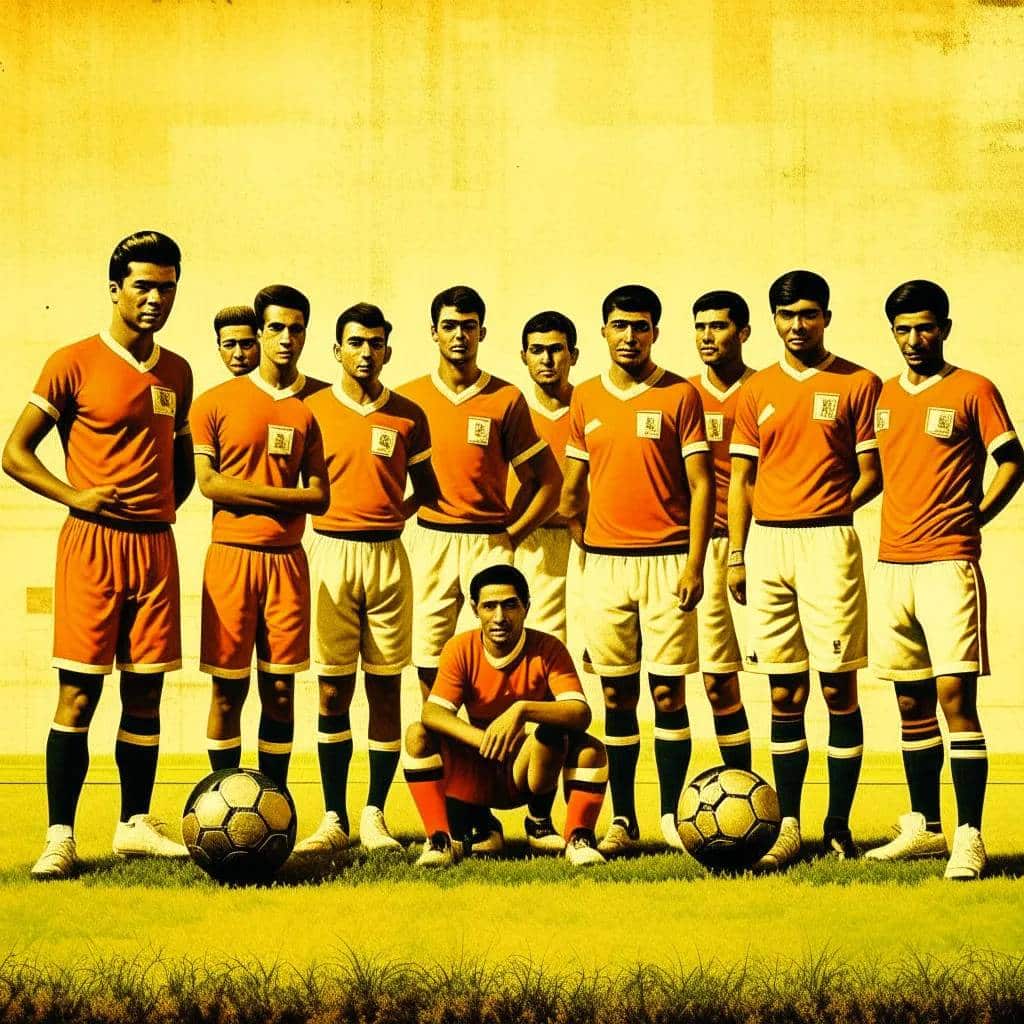Table of Contents
Have you ever wondered how the Indian national football team has evolved through the years? From its colonial origins, to its glory days, to recent struggles and a rebirth, the Indian national football team’s history has been a rollercoaster, full of ups, downs, and re-inventions. In this blog, we’ll take a look at the rich history and important milestones of the Indian national team to see how they’ve transitioned through different eras, to reach where they are now. We’ll examine the crucial turning points that have determined the team’s fate, and the strategies that have been employed to resuscitate and rebuild Indian football into a brave new global powerhouse.
Key Takeaways
- Explore the Indian national soccer team’s historical journey as we take you through its origins, golden age, the dark days, the resurgence, and today.
- Learn from what went right and wrong for the team over the years – and why. Whether it was lack of funding, challenges with infrastructure, competing priorities in the sporting world, or something else altogether.
- Learn about the initiatives and successes that have driven the revitalization of Indian football including the launch of the ISL, the Arrows project, and an uptick in FIFA ranking.
Origins and Early Years
India has a rich history in football, which dates back to the British colonial days of the mid-19th century. Football was first played by British army and navy officers and quickly caught on with the locals, becoming especially popular in Kolkata and Bengal.
Nagendra Prasad Sarbadhikari, also known as the “Father of Indian Football”, was one of the sport’s pioneering figures in India, helping generate interest and growth in the sport.
In 1924, the first international team to feature Indian AND British players toured the world, captained by Gostha Pal. A significant achievement that demonstrated that there was both interest and talent from the Indian side.
In 1937, India played their first FIFA-recognized international game in Australia, signaling that the country was ready to mix with other footballing nations. The team later toured Australia again, as well as played in Japan, Indonesia and Thailand, establishing footballing relations with those countries.
The Golden Era of the 1950s and 1960s
The 1950s and 1960s were the golden years of Indian football. The national team experienced great success, winning various gold medals at the Asian Games, and even playing in the Olympics. One high point was when they finished as runners up in the 1964 AFC Asian Cup.
But Indian football missed out on a huge opportunity in 1950, when the All India Football Federation (AIFF) elected not to send a team to the FIFA World Cup. Even though they had qualified! It remains a sore point in the country’s football history.
Decline and Revival
From the 1970s through the early 2000s, Indian football experienced a lull in international performance. Victories were seen at the club level, including East Bengal’s win in the ASEAN Championship in 2003. It was also a time when tournaments like the Federation Cup and the National Football League came into existence, shaping the structure of domestic football.
The revival phase was ushered in during the late 2000s, following India’s 2008 AFC Challenge Cup victory and improved showings in continental competitions such as the AFC Cup. The establishment of the Indian Super League (ISL) and the Indian Arrows project, served in developing players, leading to milestones like ISL clubs qualifying for the AFC Champions League and the national team advancing to the AFC Asian Cup.
Now, the Indian senior national team is led by Sunil Chhetri, a living legend in Indian football, who has taken Indian football to new heights, earning victories such as the Intercontinental Cup title on two occasions.
The Golden Era
The period from 1948 to 1970 is widely considered the “Golden Era” for Indian football. A time when India was actually good at the sport, and able to compete on the international stage, the Indian team, coached by the legendary Syed Abdul Rahim, ruled the roost in Asian football and were a force to be reckoned with.
India’s Triumph in the Asian Games
During this period, the Indian national teams were a true powerhouse at the Asian Games. In 1951, the team’s performance-winning gold proved that they really were heads-and-shoulders above the competition, skilled and strategic. They won because they were a team, they were fit, they knew each other’s game inside out, and they powered their way through a tough tournament to triumph over other Asian opposition. In 1962, they proved it was no fluke. They took gold once again, and once again made their case as the only team that could claim the title of Asian Champion in this window.
India’s Impressive Run in the AFC Asian Cup
The Indian men’s team, which won the gold medal in the Asian Games, also did very well in the AFC Asian Cup, the number 1 continental tournament. In the 1964 edition, they defied expectations to reach the final and finished as runners up—an achievement that showed they could compete against the very best. The team had the tactical, technical and mental strengths to be the best team in Asia. For them, the 1964 AFC Asian Cup was their moment, and by doing well in the tournament, demonstrated that they were one of the best teams in the continent during India’s golden era.
Memorable Performances at the Olympics
The Indian national team didn’t just stop at conquering Asia, but proved that they were a force to be reckoned with on the world stage, where they could demonstrate their skill and potential on the biggest stage of all – the Olympic Games. They had played so well that King George VI sent a letter of congratulations to the team on the way they had played. But in 1956 in Melbourne, they defeated Australia 4-2. In 1960 they lost 1-2 to Hungary in Rome, and all the newspapers back in India proclaimed and hailed the Indian football team as world-class.
The ‘Golden Era’ of Indian football 1948-1970. The above is visible testimony of their discipline, tactical acumen and skills. Winning gold at the Asian Games, runners-up at the AFC Asian Cup, performing well in the Olympics India had become dominant in Asia, and earned the enmity of other continents, writing their name in the annals of Indian sports history.

Challenges and Decline
The decades between 1970-2005 were a time of darkness for the Indian National football team. There were a number of reasons for this—poor performance on the field, poor setup off it.
Lack of Consistent Investment in Grassroots Development
There was no structure for developing young players over the long term. So there was no way to identify and nurture talented young players in a systematic and organized way. The national team never had enough talented players to be successful at the international level, because we were never able to develop depth. Neglecting the foundations of the game held back the progress of football in India. You can’t make India better without first making the team competitive.
Inadequate Infrastructure and Training Facilities
The Indian National Football team didn’t have nice, fancy training centers or nice facilities to train at during this time. And because of that, they weren’t able to perform well at international tournaments. They didn’t have the resources in order to perform to the best of their ability. They were training in less than acceptable conditions, in less than acceptable environments, and they weren’t able to provide world class facilities to develop their players. Which meant they couldn’t have world class skills, tactics, and physical fitness in order to compete at the highest levels of the sport.
Increased Competition from Other Sports
The rise and popularity of other sports, particularly cricket, in India was a big challenge for the Indian national football team during this time. As resources, attention, and funding began to go to those other sports, the Indian national football team was left with fewer resources and less money at their disposal. With the new focus on other sports, the team had to work harder to earn that attention and those resources in order to grow and play at a competitive level.
Limited Exposure to High-Level International Competitions
The Indian national football team rarely played high-level international matches, to gain the experience they needed, so they didn’t know how to compete at that level. And they never got to play lower-level games, and learn to compete in the game at all, even though they had the raw talent to do so, and even though they loved the sport. They were just cut off from the rest of the world.
And because the Indian national football team had so few chances to learn and grow from high-level games, they fell further and further behind. There were some high points, like East Bengal’s ASEAN Club Cup victory in 2003, but the Indian national team never came close to qualifying for a FIFA World Cup, and their FIFA ranking changed a lot over time, dipping as low as 169th in the world in September 2012—even though a number of new domestic football leagues had been created, like the Federation Cup and National Football League, to try to raise the level of play in India, and give the national team a real shot at holding their own on the global stage.
Revival and Modern Era
Around 2008, the Indian football team started to see a change. Good things happen to them and things were in their favor. The foundation was set, they started to win more games, and they climbed the rankings to where they are today.
ISL’s Impact on Professionalism
The introduction of the Indian Super League (ISL) in 2014 changed the game for Indian football, the professional football league key in India’s blameless ascent in the club football ranks. The ISL has helped attract the best domestic and international talent to play in India, as well as improve the country’s football infrastructure to receive more media coverage and fan interest. This has resulted in more kids wanting to play football in India, and more opportunities for them to do so. As a result of the exposure and resources that the ISL has brought to India, the game overall has also been elevated, as clubs can now afford better training facilities, better coaches, better development programs. The competition in the league has also meant that other teams in the league have improved in terms of their performances and their tactics. As a result, the league has also been good for the Indian national team, as players can gain experience playing against top quality players week-in week-out.
The Arrows Project
The Indian Arrows, a newish program, has been an effective program in developing the future of Indian football, a platform for young players to showcase their potential, play top level senior football and learn and grow under experienced coaches. They have become a platform through which even the next generation of Indian footballing superstars can emerge. With a focus on total player development – technical, tactical and physical – these players will be national team ready soon. Indian Arrows also acts as a stepping stone for the national team and a finishing school for the best Indian talent.
AFC Asian Cup Qualifications
India had qualified for the AFC Asian Cup in 2011, 2019, and 2023. That’s huge. It shows that we’re on a new level and we can hang with the best in Asia. The fact that India has qualified for AFC Cup all these years shows how much grit, smarts, and ability to perform in the clutch they have. And not only that – the experience gained from these tournaments has helped them improve their game and gain confidence and belief in themselves as a team. Plus, the continued qualification has put India on the map in Asia and the rest of the world to show that we can ball with the best of them.
Improved FIFA Rankings
The climb of the Indian National Team’s FIFA ranking has been nothing short of amazing. It’s a real indicator of how far they’ve come, and how much of a force they’re starting to become on the world stage. Rankings of 96th and 100th for 2017 and 2023 are no small feat for a side that can now easily compete with some of the best in the world. The continued rise can be attributed to many things, such as the start of the ISL, the Indian Arrows, and the National Team’s continuous qualification for the AFC Asian Cup. The 12-game undefeated streak between 2016-2017 was an exciting time for the team, as it demonstrated their ability to stubbornly hold their ground, defend, and still come out on top even against better opposition. Igor Štimac has finally taken over and started to build upon the base that was left for him. He’s already united the AFC Asian Cup, and it’s no longer just the hope for players, but it’s hope for the country, and something exciting for all of India.
Intercontinental Cup Victory
India’s victory in the 2018 Intercontinental cup was a standout performance where they proved they could hold their own against some tough competition. The fact that they got to play teams like Kenya and Chinese Taipei made it even more special. The Intercontinental Cup – where India could showcase their skills on a big stage – they didn’t fail to impress, trying out new formations, demonstrating their rock solid defense and clinical finishing. With this victory, they raised not only our spirits, but also the repute of the country. It was a testimonial to their hard work, unity, and the efforts of everyone involved in Indian football that they were able to see the day where the Indian team would be respected, loved and appreciated by their own people as well as other nations.
Draw Against Qatar
India’s 0-0 draw against reigning AFC Asian Cup champions Qatar in the qualifiers for the 2019 World Cup was a big deal. It was a match in which they demonstrated their ability to defend and to hold on. Against a team known for its offensive play, India showed that they are also able to switch to a defensive mode and to bring their opponents under control. It was further evidence of how much they have progressed in terms of system, discipline and adherence to a plan in adverse circumstances. The draw was a big deal because India not only earned an important point in the qualifiers, they also proved a point in terms of demonstrating that India can play at this level. It showed that the Indian national team can compete with the best teams in the world, that they can compete with the powerful teams of the world on the big stage.
SAFF Championship Dominance
In 2023, the India national team won the SAFF (South Asian Football Federation) Championship, and it was a huge deal. They took home their ninth SAFF Championship, and really demonstrated that they are the top dogs in South Asia. While the SAFF Championship is not as prestigious as, say, the AFC Asian Cup, or other major international tournaments, it means a lot to the Indian team, as a stage to reveal their talents and show that they are the best team in the region. And the fact that they can consistently do so well in this competition is a demonstration of not just all the talent they have, but also the coaching, and football infrastructure that exists in the country. This most recent victory not only raised the spirits of the players, but also provided a source of pride and optimism for Indian football fans, desperate for a successful national team in such a long time.
Future Prospects and Development
The future is bright for the Indian National Football team. They’re putting resources into nurturing young talent and improving infrastructure, and with good reason! They’ll be taking on a number of exciting projects to broaden the team.
Establishment of the AIFF-FIFA Academy in Bhubaneswar
Not to mention the AIFF-FIFA academy in Bhubaneswar, inaugurated by Arsene Wenger. It’s part of FIFA’s global talent development program, and a partnership between the Indian football authorities and the global body. The academy will be a training ground for young footballers, specifically those under 14. By concentrating on this age group, the academy will feed a continuous stream of trained players into contention for the national team in years to come.
Collaboration with FIFA’s Global Football Development Program
In addition to the AIFF-FIFA academy, India has a partnership with FIFA’s global football development programme, which allows India to tap into expertise and best practice from around the world. The aim here, is to use those resources to raise the standard and platforms for coaching at all levels in India. Ultimately, we want the Indian national team to be more competitive and able to play its game. It presents a fantastic opportunity to give and take ideas in how to create a unique Indian football identity, that India can own and sustain in a way that will bring positive results on the field at an international level.
Appointment of Sergi Amezcua Fontrodona as Head Coach
To spearhead the running of the FIFA-AIFF academy, the organization has recruited Sergi Amezcua Fontrodona to work as head coach. Fontrodona brings years of experience and expertise to the role, and will be moving to India from China. His leadership and guidance will be critical to implementing the academy’s vision and ensuring the best training and support for the young players. By recruiting Fontrodona, they are demonstrating their dedication to providing the children with the best resources and support to develop the next generation of Indian football talent.
Continued Participation in International Tournaments
In addition, India will continue to compete in international tournaments and matches, including against tough competition from tough countries. This is a big deal because the more chances players have to play against high-level competition, and to play in different conditions, the better-equipped they’ll be to achieve their full potential. Facing the toughest teams in the world isn’t just a great challenge for the team – it’s motivating, and will push them to keep getting better to take Indian football to new heights, improving the standard as a whole at the international level.
Overcoming Challenges
The future certainly looks bright for Indian football, but it’s still beset by a number of serious challenges. Things like infrastructure, participation at all levels, and cricket’s overwhelming popularity are going to be tough to overcome. Overcoming these challenges is going to be a long, hard climb for everyone involved (government, football association, and citizens), but with commitment and a strong strategy, the Indian national team can overcome and become a true contender in world football.
Navigating Through Football’s Past, Present, and Future in India
Football in India has a very rich history. You’ll learn the origins of football in India from British colonial rule, and key figures like Nagendra Prasad Sarbadhikari. You’ll learn about the Golden Era (1950s and 1960s) when India was winning all sorts of trophies like the Asian Games and AFC Asian Cup. You’ll learn about the struggles and downfall of Indian football from the 1970s to 2005. The struggles were real – India’s infrastructure wasn’t up to par, there was a lot of corruption in the footballing world, and other sports were getting more popular in India. You’ll learn about the revival and modern era of Indian football, with Indian football being revived by the Indian Super League (ISL) and Indian Arrows projects. India is now improving their FIFA rankings, won the Intercontinental Cup, and were even competitive in the SAFF Championship. You’ll also learn about the future and development of the Indian National Football team, and what the future holds for India to continue to nurture young talent, improve their infrastructure, and overcome all the challenges to have a prominent presence in the global football landscape.
Frequently Asked Questions
Q1: How did football originate in India?
Football in India can be traced back to the mid-19th century during British colonial rule, and was mostly played by local British army and naval officers before going on to become hugely popular, particularly in Kolkata and Bengal.
Q2: Who is considered the ‘Father of Indian Football’?
Nagendra Prasad Sarbadhikari is often referred to as the ‘Father of Indian football’ for his role in introducing and popularizing the sport in India.
Q3: What was significant about India’s first international football tour?
India’s first international tour had Indian and British players and was captained by Gostha Pal in 1924. It was a huge step for the team – it showed that they were getting better and better at football.
Q4: When did India play its first FIFA-recognized international game?
India played its first FIFA-recognized international match in Australia in 1937. Our country was part of an international football event for the first time!
Q5: Why were the 1950s and 1960s considered the golden era of Indian football?
During this time the Indian national team performed well, winning multiple gold medals at the Asian Games, and even reaching the Olympics, making it to the 1964 AFC Asian Cup final.
Q6: What was the major missed opportunity for Indian football in 1950?
In 1950, the All India Football Federation (AIFF) took the decision not to send a team to the FIFA World Cup, although India had qualified—it’s a decision that still stings in the annals of Indian football history.
Q7: What marked the decline of Indian football from the 1970s to early 2000s?
During this period, Indian football struggled to make an impact at the international level, owing to inconsistent investment in youth and player development, training infrastructure, competition from other sports (like cricket) and opportunities to compete on the world stage.
Q8: How did the Indian Super League (ISL) contribute to the revival of Indian football?
The Indian Super League (ISL)’s debut season in 2014? That’s definitely part of the equation. Indian football has been growing in popularity and professionalism over the years. The advances in domestic and international talent. Improved facilities. Increased visibility and fans.
Q9: What is the Indian Arrows project?
The Indian Arrows is a developmental tool for young football players, allowing them to play at the senior level, and has been instrumental in developing future stars for the country.
Q10: What are some recent achievements of the Indian national football team?
Recent highlights include reaching the AFC Asian Cup in 2011, 2019, and 2023, higher FIFA rankings, winning the 2018 Intercontinental Cup and a thrilling 0-0 draw against Qatar in the 2019 World Cup qualifier.
Q11: What is the significance of the AIFF-FIFA Academy in Bhubaneswar?
The AIFF-FIFA Academy Bhubaneswar, part of FIFA’s global talent development initiative is to help develop young football talent in India, focusing on under-14 year olds. It’s a unique partnership between the Indian football governing bodies, and FIFA.
Q12: Who is Sergi Amezcua Fontrodona, and what is his role?
Sergi Amezcuca Fontrodona has been appointed the new Head Coach of the AIFF-FIFA Academy in Bhubaneswar. With vast experience, he will take charge of the academy, ensuring the best training and guidance is given to the young cadets.
Q13: What challenges does Indian football still face?
Challenges include improving overall infrastructure, increasing grassroots participation, and competing with the overwhelming popularity of cricket – all of which will require sustained effort and strategic vision from all stakeholders.



